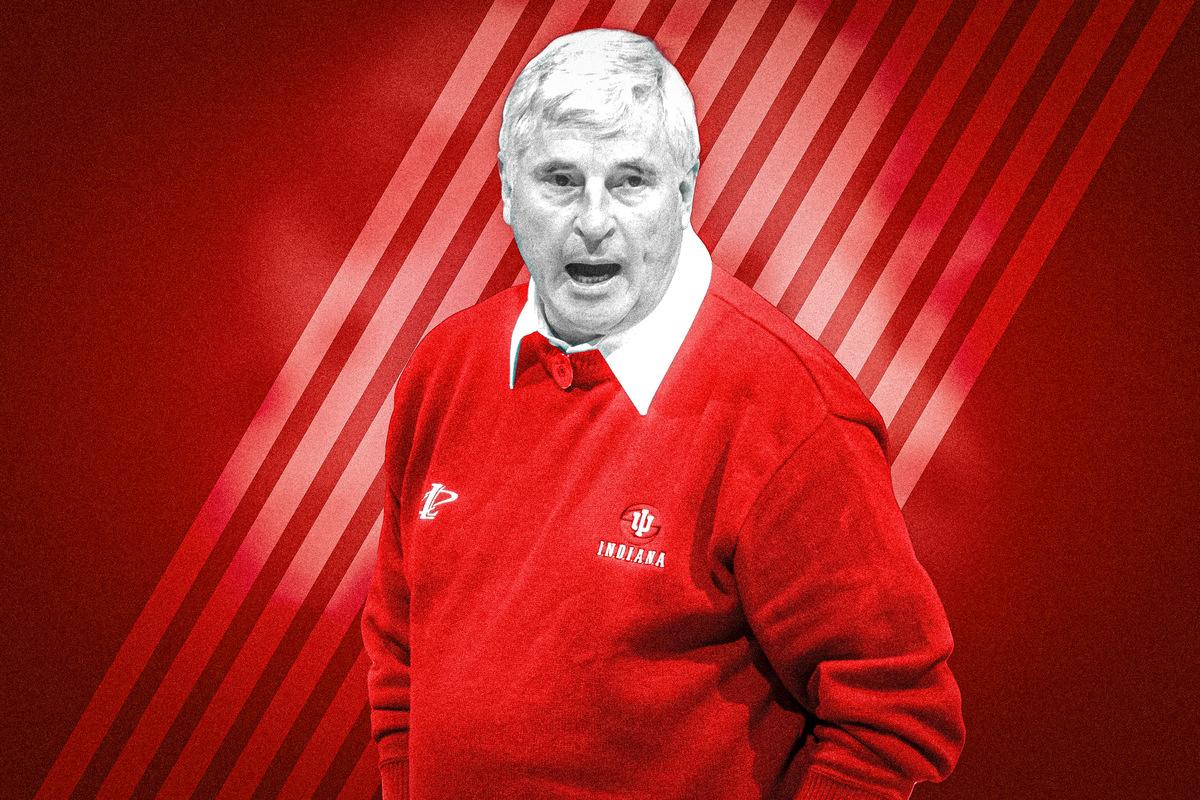Bob Knight Was Larger Than Life in Indiana. He Still Is.
Knight died Wednesday at age 83. He’ll be remembered as one of the winningest coaches in basketball history, a figure known for his temper and bullying, and a man whose influence will reverberate across Indiana for generations.
I was raised on Indiana basketball. The candy-striped pants. The five championship banners. The unfettered hatred of everything from West Lafayette. From early childhood through college, I knew going to Hoosier games at Assembly Hall was a staple of my life. But my most vivid memory of Bob Knight in Bloomington came on a golf course.
Knight loved playing golf almost as much as he loved coaching basketball. Granted, he was significantly better at the latter. Tales of him losing his temper on the course were just as common as those of him tearing into a ref from the bench. (I desperately urge you to watch this grainy video.) And I’ll never forget walking up to the driving range mats at Indiana University’s golf course as a little kid and seeing Knight smack long irons into the distance. I don’t remember how many expletives he dropped, or what his ball flight looked like. All I remember is that he was huge.
The coach known as the General cut a colossal figure in more ways than one. Knight was listed at 6-foot-5, but to an elementary school kid like me—and to pretty much everyone else who lived in Indiana during the 1970s, ’80s, and ’90s—he was larger than life. He wasn’t just the legendary coach of my favorite men’s basketball team, leading the Hoosiers to three national titles, five Final Fours, 11 Big Ten titles, and a historic undefeated season in 1975-76. Outside of many locals’ immediate family members, he was arguably the single most important person in our lives. He didn’t just put Indiana basketball on the map; he put basketball on the map in Indiana. He made it our thing. He’s why people assume I can shoot. (I can.) He was our flawed but fearless leader who led IU to unparalleled success, who retired with the most coaching wins in Division I history, and who left a trail of pain and destruction in his wake. As the saying goes: In 49 states it’s just basketball, but this is Indiana. Knight is the reason that even makes sense.
Knight died Wednesday at age 83. He’ll be remembered as one of the greatest and most influential basketball coaches in history, not only turning Indiana into a perennial powerhouse, but also leading Team USA (with a roster that included a young Michael Jordan) to the gold medal at the 1984 Summer Olympics. He revolutionized the sport with his motion offense and his authoritative, no-nonsense leadership style, and he mentored such notable coaches as Mike Krzyzewski, Chris Beard, Mike Woodson, and Bill Parcells (who worked as a part-time assistant under Knight at Army in the 1960s). But Knight will be remembered as much for his temper, bullying, and abuse as for his titles and tactics. And his exit from Indiana was as much of a spectacle as his run to the top before it.
Growing up in the ’90s, when I told people I was from Indiana, their first response was usually “Oh, Bob Knight!” By the early aughts, though, the tone of that statement had shifted. After decades of rage-filled antics led to Knight’s firing from IU in 2000—a year in which he was investigated by the university for choking a player at practice and in which he grabbed and cursed out a freshman student who had the audacity to call him “Knight,” not “Coach Knight,” to his face—the coach had turned into something of a national pariah. The sports world stopped looking past his transgressions, his awful remarks, his win-at-all-costs-even-if-that-means-kicking-your-son mentality. “Oh, Bob Knight!” suddenly became “Oh … Bob Knight.” It tore the state of Indiana apart.
Knight didn’t leave IU quietly because he didn’t do anything quietly. He gave a speech on campus the day after his firing that today feels like equal parts Woodstock and January 6. It set the tone for one of the ugliest divorces in sports history. Knight turned his back on the school and took his cult following to Texas Tech, where he coached from 2001 to 2008. Stores in Bloomington started selling Red Raiders gear right next to Hoosier garb. The move divided the entire fan base.
After spending nearly three decades at Indiana, Knight wouldn’t even utter our school’s name. He sued the university over the firing because he believed that Indiana had violated school procedures. As time went on, he remained every bit as bitter and stubborn as he was competitive. Even though new school presidents, athletic directors, head coaches, and former players made overtures for him to return to Bloomington, Knight refused to mend fences. He had no interest in burying the hatchet that he felt had stabbed him in the back. So he carried a grudge for 20 years.
It’s not particularly surprising that a man as ruthless and petty as Knight—he once raved about a fake Yugoslavian prospect named Ivan Renko just to fuck with the media—wouldn’t be easily forgiving. And for years, we didn’t just put up with his worst impulses. We celebrated them. I’m pretty sure the one thing every person in Indiana can still agree on is that Ted Valentine is an idiot. (Kidding. Sort of.) In 1994, Knight famously announced to a Bloomington crowd on senior night: “When my time on earth is gone, and my activities here are passed, I want them to bury me upside down, and my critics can kiss my ass!” We roared in delirious approval.
But the split devastated all parties. Not just for how it went down, but for how long the hurt endured. Knight’s take-no-prisoners approach is part of what made him successful on the court. His crimson iron fist was his calling card. It was also his undoing, and to him, the biggest slight of all simply couldn’t be overcome.
Indiana’s basketball program hasn’t been the same since Knight left. Interim coach Mike Davis led the Hoosiers to the national championship game just two years after Knight was gone, but it was with the players Knight had recruited. We haven’t been back since. Kelvin Sampson brought some gravitas to the team, but he left the program in complete chaos after he violated NCAA rules (something Knight, for all his warts, never did—in fact, he said in 2008, “If you get caught cheating, they should shoot you. Because you’re too dumb to be alive”). Tom Crean tried to restore Hoosier pride in the 2010s, but he didn’t have the tools. Archie Miller never really even came close.
Now Knight’s former player Woodson is trying to lead the program into the future with a hybrid of Knight’s hard-nosed principles and his own learnings from working in the NBA. But some things can’t be replicated. Indiana had a .734 winning percentage in the 29 years of Knight’s tenure; that mark is just .580 in the 23 years since he was forced out. Indiana has made just 12 NCAA tournament appearances over that span; Knight brought the Hoosiers to the tournament in each of his final 15 seasons.
The swagger hasn’t been the same either. Knight gave Indiana basketball fans a certain confidence. He delivered a dependable, winning product. He gave us something to be proud of that kept us warm all winter. Without him, the program lost its North Star. The blueprint was there, but the architect was gone. No one could build a winner like he could.
As time progressed, I never thought I’d see Knight step foot on Indiana’s campus again. Which made it all the more jarring when he finally did. Bob Knight is back? In Bloomington? In 2019, The Indianapolis Star reported that Knight’s health was declining, with the voice of the Hoosiers, Don Fischer, saying that the coach was “not well.” Not long after, Knight popped up on campus—at a baseball game, of all places (one last fuck you to the athletic department), before eventually appearing at halftime of a basketball game the following year. Word got out late that Knight would be honored at the February 10, 2020, game, and a score of former players and famous alumni, including Hall of Famer Isiah Thomas, walked hand in hand with Knight as he walked onto Branch McCracken Court and got the ovation he’d been avoiding for more than two decades.
I know this sounds ridiculous coming from a grown man, especially one jaded by sports after covering them for most of my life, but this clip rattles me to my core. It makes me as emotional as anything I’ve ever seen in basketball. Watching it now, part of me is thrilled to see the coach who taught me to love the sport back where he belongs. Part of me is touched that Knight did decide to bury the hatchet and return to Bloomington. Part of me is miffed that it actually happened after all these years, after all the things Knight said and did that can never be unsaid and undone, and that had an impact that will reverberate for years.
But most of me is incredibly sad. The moment I wanted to bring resolution felt like a folding chair to the gut. It’s the way this got to Knight that makes it so crushing. It’s his eyes that haunt me. They’re strangely kind. Not the piercing gaze that melted countless underclassmen for committing turnovers or reporters for asking unwelcome questions. The man in this video looks like Knight, but doesn’t feel like him. He’s … smiling. His gait is slow, with his head hung low. I desperately want to believe that Knight’s return was his way of making peace with IU, all the good and all the bad. But I’ll always wonder whether Indiana’s longing for closure was mutual.
At one point in his return, though, Knight summoned the coach we all remember. He didn’t give a speech; by 2020, his health had deteriorated to the point where he couldn’t talk much. But seeing a sold-out Assembly Hall crowd triggered at least one instinct. He screamed, and I mean screamed, into the sea of cream and crimson: “DEFENSE!” He shook his fist in the air as if he just got screwed by Valentine all over again. Some things can’t be taken away.
I don’t need to mince words. Knight was as legendary an asshole as he was a coach. He was an unrelenting jerk to players, the media, opponents, and anyone else who dared catch his ire. He was mean and petulant—his most iconic moment came when he threw a chair across the court against Purdue in 1985—and Indiana enabled him time after time because, well, he won a lot of fucking games. He headbutted a player, choked another, and viciously berated as many students as he helped graduate. He got charged with assaulting a police officer in Puerto Rico in 1979 and said countless unforgivable things. His track record is utterly impossible to defend.
That will be an inextricable part of his legacy just as much as his standard of winning. Which is probably why that video of his return to Assembly Hall tears me up so much. Because being an Indiana basketball fan, and being a kid raised on Bob Knight, isn’t a feel-good story. It’s complicated. Some of his players swore by him for making them into better basketball players and better men. He demanded a level of excellence that had ripple effects across the state for generations. He also humiliated us. With Knight, you have to take the bad with the good. The shame with the pride.
I’m an Indiana kid of a certain age, which means I’m a Bob Knight guy by default. I see each of his failings more clearly now, but I’m still in awe of him, much as I was on that childhood day at the golf course. I am one of so many with ties to Indiana who feel like we shared a bond with him that seemed like it could never be broken, only for it to be irrevocably shattered.
I’m glad Knight spent his last few years back in Bloomington. It’s where he belonged. And while I can’t reconcile many things about Knight’s life, I know that he left a lasting imprint on mine. He forever changed Indiana’s relationship with basketball, which forever changed Indiana’s relationship with itself. His banners will always hang in the rafters. His legacy, the best and worst of it, will carry on. I bought my kids candy-striped pants last month. One day I’ll try to explain why.

